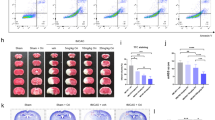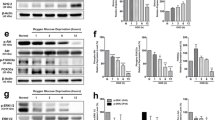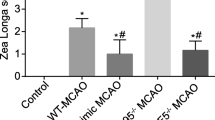Abstract
Background
Cerebral ischemia/reperfusion injury (CIRI) has complex pathogenesis, and inhibiting apoptosis and supporting neural progenitor proliferation are extremely beneficial strategies for treating CIRI. Unc-51-like kinase 4 (ULK4), a susceptibility gene for schizophrenia, promotes neural progenitors proliferation. The phosphatidylinositol 3-kinase (PI3K) pathway plays a critical role in CIRI via inhibition of apoptosis. Therefore, the relationship among ULK4, the PI3K pathway, and apoptosis in the context of CIRI has attracted our great interest.
Methods and results
Primary cortical neurons were subjected to oxygen–glucose deprivation/reperfusion (OGD/R), and rats were subjected to middle cerebral artery occlusion/reperfusion (MCAO/R). Transfection of the ULK4-overexpression lentivirus was performed alone or in combination with PI3K inhibitor treatment. Here, we revealed that ULK4 was poorly expressed in the cortex in MCAO/R rats and OGD/R-treated primary cortical neurons, ULK4 overexpression inhibited apoptosis, and reduced neurological deficit scores, cerebral infarct volume, and histopathological damage. Moreover, ULK4 overexpression increased PI3K expression and the p-protein kinase B/AKT and p-glycogen synthase kinase 3 beta (GSK3β)/GSK3β ratios, and inhibited apoptosis, while a PI3K inhibitor reversed the effects of ULK4 overexpression on CIRI.
Conclusions
ULK4 protects against CIRI, and the underlying mechanism involves PI3K pathway activation which in turn inhibits apoptosis.





Similar content being viewed by others
Data availability
The original contributions presented in the study are included in the article.
Code availability
Not applicable.
References
Benjamin EJ et al (2017) Heart disease and stroke statistics-2017 update: a report from the american heart association. Circulation 135(10):e146-146e603
Gorelick PB (2002) Stroke prevention therapy beyond antithrombotics: unifying mechanisms in ischemic stroke pathogenesis and implications for therapy: an invited review. Stroke 33(3):862–875
Samaniego EA et al (2018) Mechanical thrombectomy: emerging technologies and techniques. J Stroke Cerebrovasc Dis 27(10):2555–2571
Eltzschig HK, Eckle T (2011) Ischemia and reperfusion–from mechanism to translation. Nat Med 17(11):1391–1401
George PM, Steinberg GK (2015) Novel stroke therapeutics: unraveling stroke pathophysiology and its impact on clinical treatments. Neuron 87(2):297–309
Nakka VP et al (2008) Molecular mechanisms of apoptosis in cerebral ischemia: multiple neuroprotective opportunities. Mol Neurobiol 37(1):7–38
Liu J et al (2014) Neuronal apoptosis in cerebral ischemia/reperfusion area following electrical stimulation of fastigial nucleus. Neural Regen Res 9(7):727–734
Song J et al (2019) Inhibition of FOXO3a/BIM signaling pathway contributes to the protective effect of salvianolic acid A against cerebral ischemia/reperfusion injury. Acta Pharm Sin B 9(3):505–515
Suen DF, Norris KL, Youle RJ (2008) Mitochondrial dynamics and apoptosis. Genes Dev 22(12):1577–1590
Wang JX et al (2011) miR-499 regulates mitochondrial dynamics by targeting calcineurin and dynamin-related protein-1. Nat Med 17(1):71–78
Slupe AM et al (2013) A calcineurin docking motif (LXVP) in dynamin-related protein 1 contributes to mitochondrial fragmentation and ischemic neuronal injury. J Biol Chem 288(17):12353–12365
Herzig S, Martinou JC (2008) Mitochondrial dynamics: to be in good shape to survive. Curr Mol Med 8(2):131–137
Wu MY et al (2018) Current mechanistic concepts in ischemia and reperfusion injury. Cell Physiol Biochem 46(4):1650–1667
Zhang ZG, Chopp M (2009) Neurorestorative therapies for stroke: underlying mechanisms and translation to the clinic. Lancet Neurol 8(5):491–500
Rueger MA, Schroeter M (2015) In vivo imaging of endogenous neural stem cells in the adult brain. World J Stem Cells 7(1):75–83
Han J et al (2018) Gualou Guizhi decoction promotes neurological functional recovery and neurogenesis following focal cerebral ischemia/reperfusion. Neural Regen Res 13(8):1408–1416
Fu DL et al (2020) Sanhua decoction, a classic herbal prescription, exerts neuroprotection through regulating phosphorylated Tau level and promoting adult endogenous neurogenesis after cerebral ischemia/reperfusion injury. Front Physiol 11:57
Domínguez L, Schlosser G, Shen S (2015) Expression of a novel serine/threonine kinase gene, Ulk4, in neural progenitors during Xenopus laevis forebrain development. Neuroscience 290:61–79
Liu M et al (2016) Ulk4 regulates neural stem cell pool. Stem Cells 34(9):2318–2331
Liu M et al (2017) Multiple roles of Ulk4 in neurogenesis and brain function. Neurogenesis (Austin) 4(1):e1313646
Lang B et al (2016) Control of cortex development by ULK4, a rare risk gene for mental disorders including schizophrenia. Sci Rep 6:31126
Jaworski J et al (2005) Control of dendritic arborization by the phosphoinositide-3’-kinase-Akt-mammalian target of rapamycin pathway. J Neurosci 25(49):11300–11312
Tahirovic S, Bradke F (2009) Neuronal polarity. Cold Spring Harb Perspect Biol 1(3):a001644
Je HS et al (2011) Presynaptic protein synthesis required for NT-3-induced long-term synaptic modulation. Mol Brain 4:1
Je HS et al (2009) Chemically inducible inactivation of protein synthesis in genetically targeted neurons. J Neurosci 29(21):6761–6766
Watanabe S et al (2006) Activation of Akt signaling is sufficient to maintain pluripotency in mouse and primate embryonic stem cells. Oncogene 25(19):2697–2707
Boovarahan SR, Kurian GA (2021) Preconditioning the rat heart with 5-azacytidine attenuates myocardial ischemia/reperfusion injury via PI3K/GSK3β and mitochondrial KATP signaling axis. J Biochem Mol Toxicol. https://doi.org/10.1002/jbt.22911
Zhang K et al (2019) ALK5 signaling pathway mediates neurogenesis and functional recovery after cerebral ischemia/reperfusion in rats via Gadd45b. Cell Death Dis 10(5):360
Yang L et al (2017) Effect of PGE2-EPs pathway on primary cultured rat neuron injury caused by aluminum. Oncotarget 8(54):92004–92017
Zhang G et al (2018) Tetramethylpyrazine nitrone activates the BDNF/Akt/CREB pathway to promote post-ischaemic neuroregeneration and recovery of neurological functions in rats. Br J Pharmacol 175(3):517–531
Ye L et al (2019) FGF21 promotes functional recovery after hypoxic-ischemic brain injury in neonatal rats by activating the PI3K/Akt signaling pathway via FGFR1/β-klotho. Exp Neurol 317:34–50
Yu ZH et al (2016) PI3K/Akt pathway contributes to neuroprotective effect of Tongxinluo against focal cerebral ischemia and reperfusion injury in rats. J Ethnopharmacol 181:8–19
Lv MR et al (2017) Activation of the PI3K-Akt pathway promotes neuroprotection of the δ-opioid receptor agonist against cerebral ischemia-reperfusion injury in rat models. Biomed Pharmacother 93:230–237
Li X et al (2018) Intranasal administration of nerve growth factor promotes angiogenesis via activation of PI3K/Akt signaling following cerebral infarction in rats. Am J Transl Res 10(11):3481–3492
Liang W et al (2019) Preactivation of Notch1 in remote ischemic preconditioning reduces cerebral ischemia-reperfusion injury through crosstalk with the NF-κB pathway. J Neuroinflamm 16(1):181
Longa EZ et al (1989) Reversible middle cerebral artery occlusion without craniectomy in rats. Stroke 20(1):84–91
Hu L et al (2021) Ulk4, a newly discovered susceptibility gene for schizophrenia, regulates corticogenesis in mice. Front Cell Dev Biol 9:645368
Creppe C et al (2009) Elongator controls the migration and differentiation of cortical neurons through acetylation of alpha-tubulin. Cell 136(3):551–564
Lang B et al (2014) Recurrent deletions of ULK4 in schizophrenia: a gene crucial for neuritogenesis and neuronal motility. J Cell Sci 127(Pt 3):630–640
Wu Q et al (2020) Ligustilide attenuates ischemia reperfusion-induced hippocampal neuronal apoptosis via activating the PI3K/Akt pathway. Front Pharmacol 11:979
Feng C et al (2020) Neuroprotective effect of danhong injection on cerebral ischemia-reperfusion injury in rats by activation of the PI3K-Akt pathway. Front Pharmacol 11:298
Semba S et al (2002) The in vitro and in vivo effects of 2-(4-morpholinyl)-8-phenyl-chromone (LY294002), a specific inhibitor of phosphatidylinositol 3’-kinase, in human colon cancer cells. Clin Cancer Res 8(6):1957–1963
Gharbi SI et al (2007) Exploring the specificity of the PI3K family inhibitor LY294002. Biochem J 404(1):15–21
Acknowledgements
Special thanks are due to “Chongqing Key Laboratory of Biochemistry and Molecular Pharmacology” for providing the technical support and experimental platform.
Funding
Not applicable.
Author information
Authors and Affiliations
Contributions
JY designed the study and revised manuscript. WL performed experiments, analyzed data, and drafted manuscript. All authors read and approved the final manuscript.
Corresponding author
Ethics declarations
Conflict of interest
The authors declare that they have no competing interests.
Ethical approval
All animal experiments were conducted in accordance with the National Institute of Health Guide for the Care and Use of Laboratory Animals and were approved by the Ethics Committee of Chongqing Medical University (license number: SYXK (Chongqing) 2018-0003).
Consent to participate
Not applicable.
Consent for publication
Not applicable.
Additional information
Publisher's Note
Springer Nature remains neutral with regard to jurisdictional claims in published maps and institutional affiliations.
Rights and permissions
About this article
Cite this article
Luo, W., Yang, J. Schizophrenia predisposition gene Unc-51-like kinase 4 for the improvement of cerebral ischemia/reperfusion injury. Mol Biol Rep 49, 2933–2943 (2022). https://doi.org/10.1007/s11033-021-07108-z
Received:
Accepted:
Published:
Issue Date:
DOI: https://doi.org/10.1007/s11033-021-07108-z




